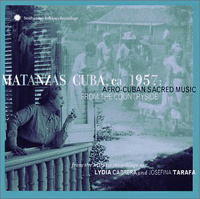|
Havana, Cuba, Ca. 1957: Rhythms and Songs for the Orishas
Matanzas, Cuba, Ca. 1957: Afro-Cuban Sacred Music from the Countryside
both titles from Smithsonian Folkways
 Rhythms and Songs for the Orishas documents an entire cycle of orisha invocations, and the percussion figures that mark their earthly presence. Afro-Cuban Sacred Music from the Countryside does the same for the sugar-growing Matanzas region some 100 kilometers east of Havana. These are field recordings of batá drummers, whose ensembles ground the sacred ceremonies of the Santería cabildos, neighborhood mutual-support organizations that formed as emancipated Afro-Cubans moved in the 1880s to urban centers in search of wage labor. Sprung from the Yoruba spirit-possession traditions still extant in present-day Nigeria, Santería deities or orishas each respond to a personal rhythmic salute, concretely manifesting their presence by taking temporary control of devotees' bodies in a moment of ecstatic communal release.
Rhythms and Songs for the Orishas documents an entire cycle of orisha invocations, and the percussion figures that mark their earthly presence. Afro-Cuban Sacred Music from the Countryside does the same for the sugar-growing Matanzas region some 100 kilometers east of Havana. These are field recordings of batá drummers, whose ensembles ground the sacred ceremonies of the Santería cabildos, neighborhood mutual-support organizations that formed as emancipated Afro-Cubans moved in the 1880s to urban centers in search of wage labor. Sprung from the Yoruba spirit-possession traditions still extant in present-day Nigeria, Santería deities or orishas each respond to a personal rhythmic salute, concretely manifesting their presence by taking temporary control of devotees' bodies in a moment of ecstatic communal release.
The recordings were made by Lydia Cabrera, an upper-class Cuban writer and painter trained in France who immersed herself in the religious traditions of Japan and India, the négritude movement's fascination with African art, and the exotic appeal of Josephine Baker, all the Parisian vogue in the late 1920s. The experience rekindled her interest in Afro-Cuban folklore, first encountered as a child cared for by black servants. Cabrera returned to Cuba in 1938 to escape the rising tide of war, taking up in earnest the study of Afro-Cuban culture.
Cabrera and photographer Josefina Tarafa (the daughter of a Cuban sugar baron) eventually recorded 14 LPs of Afro-Cuban sacred music, including these titles. Originally logged on a portable Ampex, these digitally remastered recordings capture the unadorned immediacy of sacred Afro-Cuban choral and percussive performance. Annotated by ethnomusicologist Morton Marks, with extensive notes, numerous Tarafa photographs, bibliography and discography, they are essential documentation of the music's status in Havana and Matanzas on the eve of the Cuban revolution. - Michael Stone
At cdroots.com:
Havana
Matanzas
|



